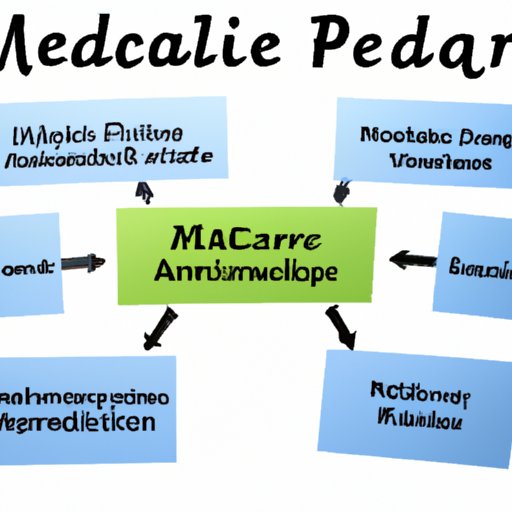Introduction
Medicare is a federal health insurance program that helps provide medical care for people who are 65 and older, as well as certain disabled individuals. It is important to understand the different parts of Medicare and how they work together in order to make sure that you get the most out of your coverage. This article will provide an overview of Medicare and its benefits, a step-by-step guide to enrolling in Medicare, stories of people who have benefited from enrolling in Medicare, tips for navigating the enrollment process, and more.

Overview of Medicare and Its Benefits
Medicare is a government-run health insurance program that helps provide medical care for people who are 65 and older, as well as certain disabled individuals. It is comprised of four different parts: Part A (hospital insurance), Part B (medical insurance), Part C (also known as Medicare Advantage plans), and Part D (prescription drug coverage). Each part provides different levels of coverage and has different rules and regulations associated with it.
Part A covers inpatient hospital care, skilled nursing facility care, hospice care, home health care, and other related services. Part B covers preventive care, doctor visits, laboratory tests, durable medical equipment, mental health services, and other medically necessary services. Part C is a type of managed care plan offered by private insurers that provide additional coverage beyond what Parts A and B offer. Part D is a prescription drug coverage plan offered by private insurers that helps cover the cost of prescription medications.
Why It is Important to Enroll in Medicare
Enrolling in Medicare is important because it can help you get the medical care you need at an affordable price. Medicare can help you save money on doctor visits, hospital stays, and prescription drugs. It also provides access to specialized care, such as cancer treatment or rehabilitation services. For those who are eligible, enrolling in Medicare can be a smart way to ensure that you have access to the care you need.
Step-by-Step Guide to Enrolling in Medicare
The process of enrolling in Medicare can seem overwhelming, but it doesn’t have to be. Here is a step-by-step guide to help you get started:
Determine Eligibility
The first step to enrolling in Medicare is determining if you are eligible. To be eligible, you must be 65 years old or older, or you must be under 65 and have been receiving Social Security or Railroad Retirement Board disability benefits for at least 24 months. You may also be eligible if you have end-stage renal disease or amyotrophic lateral sclerosis (ALS).
Gather Required Documents
Once you have determined that you are eligible, you will need to gather the required documents to complete the application. These documents include proof of identification, proof of Social Security number, and proof of citizenship or legal residency. You may also need to provide proof of income and assets.
Complete the Application
Once you have gathered the required documents, you can complete the application either online or by mail. If you choose to apply online, you will need to create an account with the Medicare website. Once you have created an account, you can fill out the application and submit it. If you choose to apply by mail, you will need to fill out the paper application and send it to the address provided.
Choose a Medicare Plan
Once your application has been approved, you will need to choose a Medicare plan that best fits your needs. You can choose from a variety of plans, including Original Medicare (Parts A and B), Medicare Advantage (Part C), and Medicare Part D (prescription drug coverage). Each plan has different levels of coverage, so it’s important to research all of your options before making a decision.

Different Parts of Medicare and How They Work Together
It is important to understand the different parts of Medicare and how they work together. Below is an overview of each part and how it works with the others:
Part A
Part A provides coverage for inpatient hospital care, skilled nursing facility care, hospice care, home health care, and other related services. Part A is free for most people who have worked and paid Social Security taxes for at least 10 years. For those who are not eligible for free Part A, there is a premium that must be paid.
Part B
Part B provides coverage for preventive care, doctor visits, laboratory tests, durable medical equipment, mental health services, and other medically necessary services. Part B also has a premium that must be paid.
Part C
Part C, also known as Medicare Advantage plans, is a type of managed care plan offered by private insurers that provides additional coverage beyond what Parts A and B offer. These plans often include prescription drug coverage, vision and dental coverage, and other benefits. Part C plans typically have higher premiums than Original Medicare, but they may also offer lower out-of-pocket costs.
Part D
Part D is a prescription drug coverage plan offered by private insurers that helps cover the cost of prescription medications. Part D plans have a premium that must be paid, and there may be additional costs for certain medications.
Benefits of Enrolling in Medicare
Enrolling in Medicare can provide several benefits, including:
Health Insurance Coverage
Medicare can help provide health insurance coverage for those who are 65 and older, as well as certain disabled individuals. It can help cover the cost of doctor visits, hospital stays, and other medically necessary services.
Prescription Drug Coverage
Medicare Part D provides prescription drug coverage for those who are enrolled in the program. This coverage can help cover the cost of prescription medications and can be a great way to save money on medications.
Financial Savings
Medicare can help you save money on doctor visits, hospital stays, and prescription drugs. It can also help you save money on other medical expenses, such as durable medical equipment and home health care.
Access to Specialized Care
Medicare can also provide access to specialized care, such as cancer treatment or rehabilitation services. This specialized care can help improve your quality of life and give you peace of mind knowing that you are getting the care you need.

Stories of People Who Have Benefited from Enrolling in Medicare
There are many stories of people who have benefited from enrolling in Medicare. These stories provide insight into how enrolling in Medicare can improve a person’s quality of life. Here are some examples:
Personal Accounts of Experiences
One woman shared her story of enrolling in Medicare and how it helped her get the medical care she needed. She had been struggling to pay for her medical bills, but when she enrolled in Medicare, she was able to get the care she needed at an affordable price. Another man shared his story of how enrolling in Medicare allowed him to get the prescription drugs he needed to manage his chronic condition.
Examples of Improved Quality of Life
One woman shared her story of how enrolling in Medicare allowed her to get the specialized care she needed to treat her cancer. She was able to get the treatments she needed without having to worry about the cost. Another man shared his story of how enrolling in Medicare allowed him to get the prescription drugs he needed to manage his chronic pain. He was able to get the relief he needed and improve his quality of life.
Compare Private Insurance Options with Medicare
When it comes to choosing health insurance coverage, it is important to compare private insurance options with Medicare. Here are some of the advantages and drawbacks of both:
Advantages of Private Insurance
Private insurance plans often have lower premiums than Medicare. They may also provide more flexibility in terms of coverage, allowing you to customize your plan to fit your needs. In addition, private insurance plans usually have shorter waiting periods for pre-existing conditions.
Drawbacks of Private Insurance
Private insurance plans often come with higher out-of-pocket costs, such as co-pays and deductibles. In addition, they may not cover certain services, such as mental health services or durable medical equipment. Private insurance plans also may not cover pre-existing conditions.
Advantages of Medicare
Medicare offers comprehensive coverage for those who are eligible. It covers a wide range of services, including doctor visits, hospital stays, and prescription drugs. Medicare also provides access to specialized care, such as cancer treatment or rehabilitation services. In addition, there are no waiting periods for pre-existing conditions.
Drawbacks of Medicare
Medicare often has higher premiums than private insurance plans. It also does not cover certain services, such as vision or dental care. In addition, Medicare does not cover long-term care services, such as nursing home care.

Tips for Navigating the Medicare Enrollment Process
Navigating the Medicare enrollment process can seem daunting, but there are several steps you can take to make it easier:
Get Help from Professionals
If you need help understanding the different parts of Medicare or how to complete the application, it is a good idea to seek the advice of professionals. You can speak to a local Medicare representative or a trusted financial advisor who can help you make sense of the process.
Research Your Options Thoroughly
It is important to research all of your options thoroughly before deciding which Medicare plan is right for you. Make sure to compare all of the different plans and their coverage levels to determine which one is best suited for your needs.
Use Online Resources
There are many online resources available to help you understand the Medicare enrollment process. The Medicare website is a great place to start, as it provides information on eligibility, enrollment, and the different parts of Medicare. There are also many other websites and blogs that provide helpful information and advice.
Understand the Timeframe
It is important to understand the timeframe for enrolling in Medicare. Generally, you can enroll up to three months before your 65th birthday, during the month of your 65th birthday, or up to three months after your 65th birthday. It is important to keep this timeframe in mind when planning to enroll in Medicare.
Conclusion
Enrolling in Medicare can be a confusing and overwhelming process, but it is an important step to take in order to ensure that you get the medical care you need. This article provided an overview of Medicare and its benefits, a step-by-step guide to enrolling in Medicare, stories of people who have benefited from enrolling in Medicare, tips for navigating the enrollment process, and more. Understanding the different parts of Medicare and how they work together, as well as researching all of your options thoroughly, can help make the process easier.
(Note: Is this article not meeting your expectations? Do you have knowledge or insights to share? Unlock new opportunities and expand your reach by joining our authors team. Click Registration to join us and share your expertise with our readers.)
